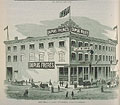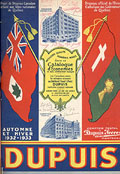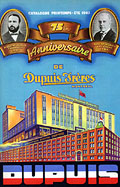|
|
| |
 |
|
| |
 The
Dupuis Frères department store, Montreal, 1877, L'Opinion
publique,
November 9, 1877. The store founded by Nazaire Dupuis in 1868 was located
at the corner of St. Catherine and Berri Streets in Montréal. It
closed
its doors in 1978. The
Dupuis Frères department store, Montreal, 1877, L'Opinion
publique,
November 9, 1877. The store founded by Nazaire Dupuis in 1868 was located
at the corner of St. Catherine and Berri Streets in Montréal. It
closed
its doors in 1978.
|
|
| |
|
|
|
Founded in 1868, Dupuis Frères, a family
company, quickly
grew into one of Montréal's largest department stores.
Through its
mail-order service and its catalogues, the French Canadian firm became
known
nationwide.
The Mail-order Service | The
Catalogues
| The Decline | The Closure
| Further Reading
Originally from Saint-Jacques-de-l'Achigan, Quebec, the Dupuis,
like
many other families, arrived in Montréal in 1864 seeking wealth and
a
new way to earn a living. Four years later, Nazaire Dupuis, the eldest
son, opened
a small store that developed into a successful business.
In 1870, the store was named Dupuis Frères. When it was
incorporated
and obtained a federal charter in 1908, the word
"Limitée"
was added to the name. The period between was a difficult one. In 1897, as
a
result of bad investments, Odilon Dupuis was forced to sell the business
to his
brother Narcisse. The positive economic climate that preceded the First
World
War helped the company regain its profits. Three new managers were
recruited
from the competition, including A.-J. Dugal, who remained on the executive
for
40 years. In the 1920s, the store was considered one of the two or three
largest
in Montréal. The development of the family business was indeed
impressive.
In a short time, it became the commercial crossroads of the city's
francophone
community.
| |
 |
|
| |
 Dupuis
Frères Fall/Winter Catalogue, 1932-1933, cover, clearly illustrating
the patriotism that was at the heart of the company's marketing strategy. Dupuis
Frères Fall/Winter Catalogue, 1932-1933, cover, clearly illustrating
the patriotism that was at the heart of the company's marketing strategy.
|
|
| |
|
|
|
French Canadian consumers were proud of Dupuis Frères. To obtain
such
recognition, the company highlighted its French Canadian roots in its
marketing
strategy. It appealed directly to French Canadians' sense of pride.
In
1927, for example, the following words, tinged with chauvinism, appeared
in Le
Duprex, the employee newsletter: "In a country such as ours,
submerged
by immigration, surrounded by U.S., British or Jewish financing, we do not
have
the right to be ordinary, mediocre, inferior, and to resign ourselves to
the
perpetual role of hewers of wood and drawers of water, obsequious and
fearful
servants." [transl.]
In the 1930s and 1940s, the company participated actively in the
"buy
domestic" campaigns aimed at encouraging French Canadian businesses.
Mail order also contributed to the development and popularity of Dupuis
Frères.
Through its mail-order service, the company became known throughout
Quebec, as
well as outside the province.
|
The Mail-order Service
| |
 |
|
| |
 The
Dupuis Frères Spring/Summer Catalogue, 1943, cover. This issue
marked
Dupuis' 75th anniversary. The company's two imposing buildings, the
department
store on St. Catherine Street, and the mail-order department on Brewster
Street, provide an indication of its success. The
Dupuis Frères Spring/Summer Catalogue, 1943, cover. This issue
marked
Dupuis' 75th anniversary. The company's two imposing buildings, the
department
store on St. Catherine Street, and the mail-order department on Brewster
Street, provide an indication of its success.
|
|
| |
|
|
|
When the mail-order service was launched in 1921, 20 000 copies of
the
catalogue were printed. Written in French only, it had about 30 pages and
contained
over 500 items. In 1942, over a million catalogues were distributed. In
the late
1940s, mail-order offices were opened in several cities in Quebec:
Jonquière,
La Tuque, Rimouski, Rivière-du-Loup, Sept-Îles and
Val-d'Or.
| |
 |
|
Dupuis Frères parcel
label.
The slogan on this label used by the company's mail-order department
- Reçue AUJOURD'HUI, Expédiée AUJOURD'HUI (Received
TODAY, Shipped TODAY)
- reflects the quality, efficiency, and speed of the service.
|
 |
|
|
| |
| |
 |
|
| |
 Dupuis
Frères, delivery vehicle. Horse-drawn vehicles such as this one were
used until the mid-1920s, when they were replaced by trucks. Le
Duprex,
6 (4) (January 1932): 45. Dupuis
Frères, delivery vehicle. Horse-drawn vehicles such as this one were
used until the mid-1920s, when they were replaced by trucks. Le
Duprex,
6 (4) (January 1932): 45.
|
|
| |
|
|
|
In the early 1930s, Dupuis received up to 10 000 orders a day. The
mail-order
department had to be moved to a larger building in the Saint-Henri area. A
new
exchange was installed so that orders could be placed by telephone. The
company
proudly declared in Le Duprex that it was known from coast to
coast
because of its mail-order business.
A report published in 1934 by the Royal Commission on Price Spreads and
Mass
Buying reveals that, despite its image of success, Dupuis Frères
had deficits.
The document includes the company's annual sales figures for the
period
of 1925 to 1934. According to the Commission, the mail-order division had
a deficit
every year. For example, the losses totalled $9800 in 1928 and
$68 000 in
1934. The statistics for Simpson's follow a similar pattern. The
Depression
partly responsible.
|
The Catalogues
The Dupuis Frères catalogues offered a wide variety of items:
clothing
for all members of the family, lingerie, undergarments, medicinal
products, and
household appliances such as electric stoves and irons. Religious articles
were
also included, but the company published a separate catalogue for the
clergy.
Sports equipment could also be purchased from the catalogue. Each year,
hockey
was featured in the fall-and-winter catalogue and baseball in the
spring-and-summer
edition. The sale of certain items, therefore, depended directly on the
season
and on how well the company was doing. In 1952-1953, for example,
there
was a great demand for the undergarments featured in the fall-and-winter
catalogue,
especially the long underwear for men. The company earned $19 300
from the
sale of 6000 undergarments (long underwear, undershirts, and boxer
shorts). Over
the same period, 260 coats and suits for men brought in $16 700.
Women were targeted by the catalogues. The section devoted to
women's
clothing was more striking than the others and had the most pages and the
most
colour.
|
The Decline
Although the economic situation improved after the Second World War,
the 1950s
and 1960s were difficult for Dupuis. The company tried new marketing
strategies
in an attempt to project a more youthful image, but it was a waste of
time. Because
of the numerous confrontations associated with the 1952 strike, everyone
—
managers, employees, and customers — lost confidence in the company.
Sales
plummeted and mail orders could not be filled on time. Dupuis discontinued
its
mail-order service in January 1963, a few months after the last catalogue
was
published. In 1964, strikes and lockouts once again disrupted the
company's
activities. Mounting financial problems forced Dupuis Frères to
close
its doors in 1978. The family had sold the business in 1961.
| |
 |
|
The 1952 strike at Dupuis
Frères. Officers of Montreal's mounted police force were called in
to
maintain order among striking workers.
|
 |
|
|
The Closure
Three factors contributed to the closure: the location of the store at
the
east end of Berri Street, which isolated it from the other department
stores
in the downtown area; the competition; and the decreasing loyalty of
francophone
customers, who gradually turned to other companies on St. Catherine Street
or
suburban shopping centres.
In 1978, when Dupuis Frères sought protection under the
Bankruptcy
and Insolvency Act and closed its doors, 700 people found themselves
out
of work and without compensation. The company had many creditors and the
employees
were last in line. Much later in November 1989, the company's former
employees
received some compensation and, in February 1990, they were finally
granted full
compensation. Thus disappeared a company that claimed to spearhead the
economic
ambitions of the French Canadian "race."
|
|
Further Reading
Dupuis-Leman, Josette. Dupuis Frères, le magasin du
peuple.
Montréal: Stanké, 2001.
Fonds d'archives de Dupuis Frères Limitée,
1868-1978,
École des hautes études commerciales de Montréal, HEC
P049.
Lefebvre, Jean-Marie. "Nazaire Dupuis." In Dictionary
of Canadian
Biography Online, vol. X (1871-1880). © 2000 University of
Toronto/Université
Laval. <http://www.biographi.ca>
Matthews, Mary Catherine. "Working for Family, Nation and God:
Paternalism
and the Dupuis Frères Department Store, Montreal,
1926-1952."
MA thesis, McGill University, 1998.
Trudel, Robert. "Famille, Foi et Patrie: Le credo de Dupuis
Frères."
Cap-aux-Diamants, 40 (Winter 1995): 26-29.
|
| |
|
|